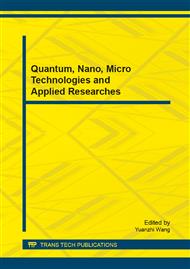[1]
G. Pantazopoulos: J. Mater. Eng. Perform. 11, 402-407, (2002).
Google Scholar
[2]
Japan Capper and Brass Association, Base and Industrial technology of copper and copper alloys (in Japanese). (1994).
Google Scholar
[3]
P. García, S. Rivera, M. Palacios, J. Belzunce: Eng. Fail. Anal. 17, 771-776 , (2010).
Google Scholar
[4]
E. W. Thiele, K. J.A. Kundig, D. W. Murphy, G. Soloway, B. Duffin: CDA's Universal Machinability Index. SAE Technical Paper Series, No. 900365, International Congress and Exposition, Detroit, MI, (1990).
DOI: 10.4271/900365
Google Scholar
[5]
J. X. Wu, M. R. Ji, M. Galeotti, A. M. Giusti, G. Rovida: Surf. Interface Anal. 22 , 323-326, (1994).
DOI: 10.1002/sia.740220170
Google Scholar
[6]
X. Chen, A. Hu, M. Li, D. Mao: J. Alloys Compd. 460, 478-484, (2008).
Google Scholar
[7]
S. Kuyucak, M. Sahoo: Can. Metall. Q. 35, 1–15, (1996).
Google Scholar
[8]
B. D. Mellow, D. J. Thomas, M. J. Joyce, P. Kolkowski, N. J. Roberts, S. D. Monk: Nucl. Instrum. Methods Phys. Res. A 577, 690-695, (2007).
Google Scholar
[9]
RoHS and WEEE compliant flame retardants developed for electrical connectors, Reinf. Plastics 51, 12, (2007).
DOI: 10.1016/s0034-3617(07)70234-5
Google Scholar
[10]
C. Mans, S. Hanning, C. Simons, A. Wegner, A. Janβen, M. Kreyenschmidt: Spectrochim. Acta Part B 62, 116–122, (2007).
DOI: 10.1016/j.sab.2007.02.001
Google Scholar
[11]
V. L. Whiting, D. P. Newcombe, M. Sahoo: Trans. Am. Foundrymen's Soc. 103, 683-691, (1995).
Google Scholar
[12]
A. L. Fontaine, V.J. Keast : Mater. Charact. 57, 424-429, (2006).
Google Scholar
[13]
V. Vazquez, A. Juarez-Hernandez, A. Mascarenas, P. Zambrano, M.A.L. H. Rodriguez : Eng. Fail. Anal. 17, 1285-1289, (2010).
Google Scholar
[14]
H. Imai, Y. Kosaka, A. Kojima, S. Li, K. Kondoh, J. Umeda, H. Atsumi: Mater. Trans. 51, 855-859, (2010).
Google Scholar
[15]
Tetsuya Andoh, Tetsuro Atsumi, Yoshiro Yoshikawa: J. JCBRA. 40, 253-256, (2001).
Google Scholar
[16]
K. Kondoh, H. Imai, J. Umeda, Y. Kousaka, A. Kojima: Trans. JWRI. 37, 87-89, (2008).
Google Scholar
[17]
H. Imai, Y. Kosaka, A. Kojima, S. Li, K. Kondoh, J. Umeda, H. Atsumi: Powder Technol. 198, 417-421, (2010).
DOI: 10.1016/j.powtec.2009.12.010
Google Scholar
[18]
U. Borggren, M. Selleby: J. Phase Equilib. 24, 110-121, (2003).
Google Scholar
[19]
H. Mindivan, H. Çimenoˇglu, E.S. Kayali: Wear 254, 532-537, (2003).
Google Scholar
[20]
M. Sundberg, R. Sundberg, S. Hogmark, R. Otterberg, B. Lehtinen, S. E. Hgrnstrgm, S. E. Karlsson, Wear 115, 151-165, (1987).
DOI: 10.1016/0043-1648(87)90206-7
Google Scholar
[21]
G. Mauvoisin, O. Bartier, R. El Abdi, A. Nayebi, Int. J. Mach. Tools Manuf. 43, 825-832, (2003).
DOI: 10.1016/s0890-6955(03)00051-8
Google Scholar
[22]
C. Vilarinho, J.P. Davim, D. Soares, F. Castro, J. Barbosa, J. Mater. Proc. Technol. 170, 441-447, (2005).
Google Scholar
[23]
L. Jin, R. Sandstrm, Mater. Design 15, 339-346, (1994).
Google Scholar
[24]
H. Atsumi, H. Imai, S. Li, Y. Kousaka, A. Kojima, K. Kondoh, Mater. Sci. Forum 654- 656, 2552-2555, (2010).
DOI: 10.4028/www.scientific.net/msf.654-656.2552
Google Scholar
[25]
S. Li, H. Imai, H. Atsumi, K. Kondoh, J. Alloys Compd. 493, 128-133, (2010).
Google Scholar
[26]
S. Ikeno, K. Matusda, Y. Nakamura, T. Kawabata, Y. Uetani, J. JIRICu. 43, 26-30, (2004).
Google Scholar
[27]
S. Li, K. Kondoh, H. Imai, H. Atsumi, Powder Technol. 205, 242–249, (2011).
Google Scholar
[28]
H. Atsumi, H. Imai, S. Li, K. Kondoh, Y. Kousaka, A. Kojima: Mater. Chem. Phys. 135, 554-562, (2012).
Google Scholar
[29]
N. Shinozaki, Jun Morita, K. Wasai, J. Inst. Light Met. Jpn. 55, 310-314, (2005).
Google Scholar
[30]
T. Sato, A. Kato, K. Arai, H. Takizawa, S. Arai, J. Met. Finish. Soc. Jpn. 59, 265-267, (2008).
Google Scholar


